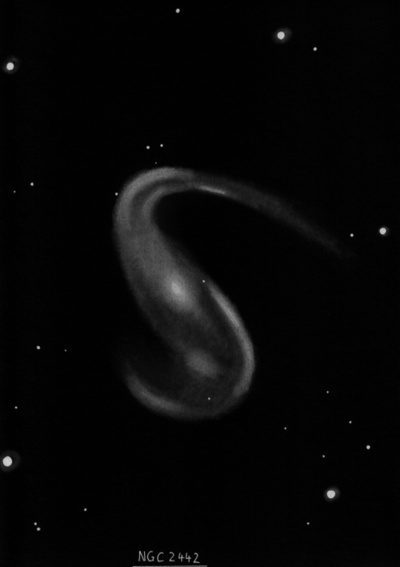A small and relatively obscure constellation in the southern sky that doesn't stand out much near the rich part of the Milky Way. It is located just near the south celestial pole under the bright star Canopus, between the keel star Miaplacidus and the Great Magellanic Cloud. There are no interesting objects in the constellation, with only one deep-sky spiral galaxy of 11th magnitude, seen from above, attracting attention.
β Vol - The brightest star of the constellation, a star with an apparent magnitude of 3.7. This orange giant is located at a distance of 108 light years.
γ Vol - An attractive double star for a small telescope, with components of brightness 3.8mag and 5.7mag, located at a distance of 13.6". They have an orange and yellow color.
ε Vol - Double star composed of components with magnitudes 4 and 7, which can be resolved using a small telescope. Their separation is 6".
κ Vol - The double star is easily distinguishable even in a telescope. The primary component with a brightness of 5.4 magnitude is located at a distance of 65 arcseconds from the companion with a brightness of 5.7 magnitude. At a separation of 37 arcseconds, there is another companion of 9th stellar magnitude.
S Vol - A variable star of the Mira type, whose maximum is usually around 8.6 mag, sometimes even 7.7 mag. However, it only drops to 13.6 mag at minimum. This entire cycle takes place over a period of 14 months.
NGC 2442

John Herschel discovered NGC 2443 = h3097 on 23 Dec 1834. In sweep 523, he described a "double nebula, vL, vF, position of centres = 40 deg, diameters 4' and 3' running together and having a star 13m at their junction." JH assigned two GC designations for the double nebula (GC 1568 and 1569) and they received two NGC designations, NGC 2442 and NGC 2443, although the latter number refers to the massive spiral arm on the northeast side of NGC 2442.
400/500mm - 20" f/5 (7/8/02 - Magellan Observatory, Australia): This is the NE portion or NE spiral arm of NGC 2442. At 127x (20 Nagler), on the NE end of the bar, a faint "arm" emerged at a sharp angle towards the NW. The contrast was improved at 212x and the brighter arm was easier to view, extending at nearly a right angle to the main body and curving towards the east on the north side.
600/800mm - 24" (4/4/08 - Magellan Observatory, Australia): This number refers to the prominent arm attached at the NE end of the bar. This arm extends a short distance in that direction before dramatically bending sharply to the west (turning nearly 150°) and extending ~3.5' in length towards a mag 12.9 star. At the NW end this well-defined arm fades and broadens a little, terminating just SE of the mag 13 star. See NGC 2442 for full description of the galaxy.
Notes by Steve Gottlieb